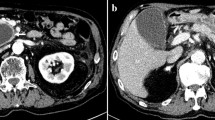Abstract
Pseudoaneurysms due to chronic pancreatitis can be a source of major gastrointestinal (GI) hemorrhage. Computed tomography (CT) is the primary diagnostic imaging modality for pancreatic pseudocysts associated with GI bleeding can be diagnosed and embolized with transcatheter techniques once the arterial anatomy is defined. CT is a useful modality for follow-up examination of the pseudocyst; the findings must be correlated with other procedures performed on these patients. On follow-up studies, contrast medium retained in the pseudocyst after embolization may falsely signal persistent bleeding into the pseudocyts.
Similar content being viewed by others
References
White AF, Baum S, Suranasiri S, (1976) Aneurysms secondary to pancreatitis. AJR 127:393–396
Mandel SR, Jaques PF, Mauro MA, Sanofsky S, (1987) Nonoperative management of peripancreatic arterial aneurysms: A tenyear experience. Ann Surg 205:126–128
Gadacz TR, Trunkey D, Kieffer RF (1978) Visceral vessel erosion associated with pancreatitis, Arch Surg 113:1438–1440
Vujic I (1989) Vascular complications of pancreatitis. Radiol Clin North Am 27:81–91
Mauro M, Jaques P, (1991) Transcatheter managment of pseudoaneurysms complicating pancreatitis. J Vasc Intervent Radiol 2:527–532
Boudghene F, L'Hermine C, Bigot JM (1993) Arterial complications of pancreatitis: Diagnostic and therapeutic aspects in 104 cases. J Vasc Intervent Radiol 4:551–558
Baker KS, Tisnado J, Cho SR, Beachley MC (1987) Splanchnic artery aneurysms and pseudoaneurysms: Transcatheter embolization. Radiology 163:135–139
Salam TA, Lumsden AB, Martin LG, Smith RB (1992) Nonoperative management of visceral aneurysms and pseudoaneurysms. Am J Surg 164:215–219
Greenstein A, DeMaio EF, Nabseth DC (1971) Acute hemorrhage associated with pancreatic pseudocysts. Surgery 69:56–62
Stabile BE, Wilson SE, Debas HT (1983) Reduced mortality from bleeding pseudocysts and pseudoaneurysms caused by pancreatitis. Arch Surg 118:45–51
Foley WD, Berland LL, Lawson TL, Maddison FE (1980) Computed tomography in the demonstration of hepatic pseudoaneurysm with hemobilia. J Comput Assist Tomogr 4:863–865
Lamorgese B (1988) Aneurysms of superior mesenteric artery: CT demonstration, J Comput Assist Tomogr 12:1059–1060
Nino-Murcia M, Kurtz A, Brennan RE, Shaw E, Peiken SR, Weiss SM (1983) CT diagnosis of a splenic artery pseudoaneurysm: A complication of chronic pancreatitis and pseudocyst formation J Comput Assist Tomogr 7:527–529
Balthazar EJ (1989) CT diagnosis and staging of acute pancreatitis. Radiol Clin North Am 27:19–37
Author information
Authors and Affiliations
Rights and permissions
About this article
Cite this article
Winick, A.B., Malloy, P.C. & Lund, G.B. Retained contrast after embolization of a right gastric artery pseudoaneurysm. Cardiovasc Intervent Radiol 19, 110–112 (1996). https://doi.org/10.1007/BF02563904
Issue Date:
DOI: https://doi.org/10.1007/BF02563904




